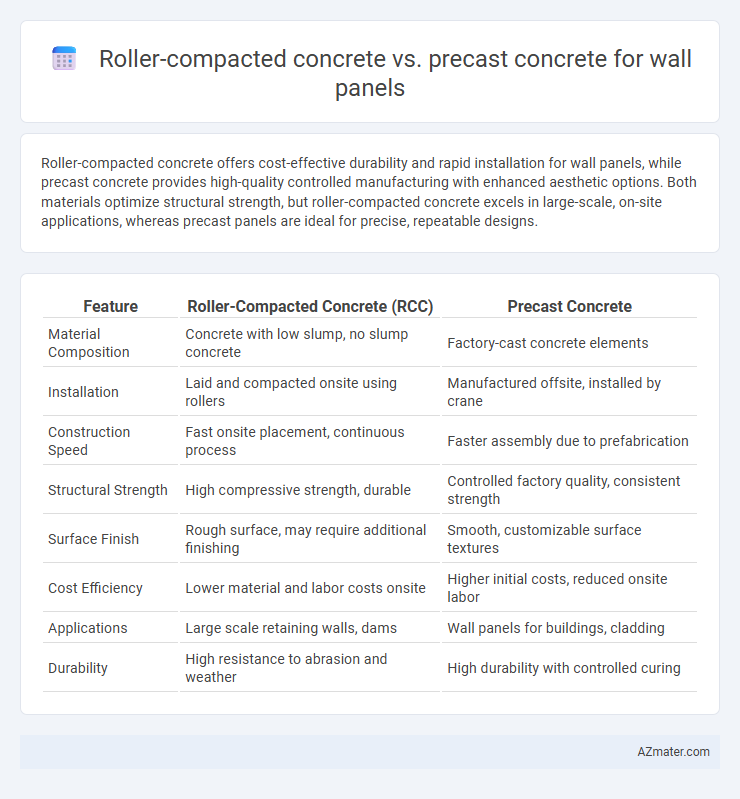Roller-compacted concrete offers cost-effective durability and rapid installation for wall panels, while precast concrete provides high-quality controlled manufacturing with enhanced aesthetic options. Both materials optimize structural strength, but roller-compacted concrete excels in large-scale, on-site applications, whereas precast panels are ideal for precise, repeatable designs.
Table of Comparison
| Feature | Roller-Compacted Concrete (RCC) | Precast Concrete |
|---|---|---|
| Material Composition | Concrete with low slump, no slump concrete | Factory-cast concrete elements |
| Installation | Laid and compacted onsite using rollers | Manufactured offsite, installed by crane |
| Construction Speed | Fast onsite placement, continuous process | Faster assembly due to prefabrication |
| Structural Strength | High compressive strength, durable | Controlled factory quality, consistent strength |
| Surface Finish | Rough surface, may require additional finishing | Smooth, customizable surface textures |
| Cost Efficiency | Lower material and labor costs onsite | Higher initial costs, reduced onsite labor |
| Applications | Large scale retaining walls, dams | Wall panels for buildings, cladding |
| Durability | High resistance to abrasion and weather | High durability with controlled curing |
Introduction to Wall Panel Construction Methods
Roller-compacted concrete (RCC) and precast concrete represent two prominent methods for wall panel construction, each with distinct advantages in structural performance and installation speed. RCC offers rapid on-site placement with minimal formwork, making it suitable for large-scale, monolithic walls with enhanced durability and reduced construction time. Precast concrete panels provide precise quality control and accelerated assembly due to factory fabrication, enabling consistent finishes and integration of embedded features before transport to the construction site.
Overview of Roller-Compacted Concrete (RCC)
Roller-compacted concrete (RCC) is a dense, low-slump concrete mixture compacted by rollers, offering high strength and durability, making it suitable for wall panel construction under heavy load conditions. RCC requires less cement and water than traditional concrete, resulting in cost efficiency and faster placement without formwork. Its superior resistance to abrasion and freeze-thaw cycles enhances the longevity of wall panels compared to conventional precast concrete methods.
Understanding Precast Concrete Wall Panels
Precast concrete wall panels are factory-made, offering precise control over quality, finish, and dimensional accuracy, which results in consistent structural performance and faster on-site installation. Roller-compacted concrete, though cost-effective and rapid to place, lacks the refined texture and predefined shapes achievable with precast panels, making it less suitable for architectural wall applications. Understanding the manufacturing process, curing conditions, and design flexibility of precast concrete wall panels is essential for optimizing durability, thermal insulation, and load-bearing capacity in building construction.
Material Properties: RCC vs Precast Concrete
Roller-compacted concrete (RCC) exhibits high compressive strength and excellent durability due to its low water-cement ratio and dense internal structure, making it ideal for heavy-load wall panels. Precast concrete offers superior control over material consistency, allowing for enhanced surface finishes and customized reinforcement integration, which improves tensile strength and reduces permeability. Both materials provide excellent fire resistance and thermal mass properties, but RCC is typically more cost-effective for large-scale, monolithic wall structures, while precast panels excel where precise dimensional tolerances and aesthetic quality are critical.
Manufacturing Process Comparison
Roller-compacted concrete (RCC) walls are manufactured by spreading and compacting a dry concrete mix using heavy rollers, allowing for rapid, on-site construction with minimal formwork. Precast concrete wall panels are factory-cast in controlled environments using molds, ensuring high precision, uniformity, and quality control before transportation to the site. RCC offers faster production for large-scale projects, while precast panels provide better dimensional accuracy and finish consistency due to their controlled manufacturing process.
Installation and Construction Speed
Roller-compacted concrete (RCC) offers rapid on-site installation with continuous placement using heavy machinery, reducing overall construction time for wall panels. Precast concrete wall panels provide faster assembly through factory-controlled production and just-in-time delivery, minimizing on-site labor and delays. While RCC excels in large-scale, continuous wall applications, precast panels enhance speed in modular, repetitive designs by streamlining installation processes.
Structural Performance and Durability
Roller-compacted concrete (RCC) wall panels exhibit exceptional structural performance due to their high density and low permeability, providing enhanced load-bearing capacity and resistance to cracking. Precast concrete panels offer superior durability through controlled factory conditions, enabling precise curing and reinforcement placement that improve long-term strength and resistance to environmental stressors. Both RCC and precast concrete demonstrate robust structural integrity, but RCC is often preferred for large-scale, continuous applications while precast panels excel in modular construction with consistent quality control.
Cost Analysis and Budget Considerations
Roller-compacted concrete (RCC) for wall panels typically offers lower material costs and faster placement, reducing labor expenses compared to precast concrete, which involves higher upfront costs due to factory fabrication and transportation. Budget considerations favor RCC when project timelines are tight and site conditions allow for in-situ compaction, while precast concrete panels provide cost predictability and quality control beneficial for complex architectural requirements. Lifecycle costs should include maintenance, with precast panels often requiring less repair, offsetting their initial higher investment over time.
Sustainability and Environmental Impact
Roller-compacted concrete (RCC) offers enhanced sustainability through its reduced cement content and lower water usage, which decreases carbon emissions compared to traditional precast concrete panels. Precast concrete wall panels provide durability and quality control, but often involve higher embodied energy due to transportation and factory processing. RCC's on-site placement minimizes transportation impacts and promotes resource efficiency, making it a more environmentally friendly option for sustainable wall panel construction.
Best Applications: Choosing the Right Wall Panel Solution
Roller-compacted concrete (RCC) offers a cost-effective and durable solution ideal for large-scale infrastructure projects requiring rapid placement and high compressive strength, such as retaining walls and sound barriers. Precast concrete wall panels provide superior quality control, faster installation, and customizable aesthetics, making them optimal for commercial buildings and architectural facades. Selecting between RCC and precast concrete depends primarily on project scale, design complexity, and construction timeline requirements.

Infographic: Roller-compacted concrete vs Precast concrete for Wall panel
 azmater.com
azmater.com